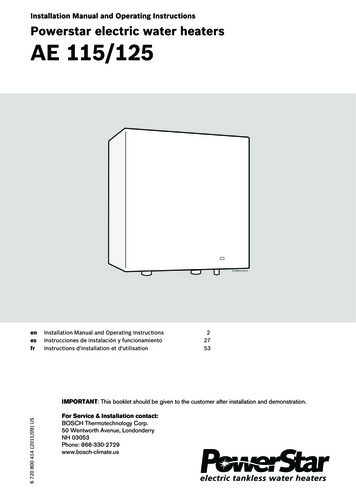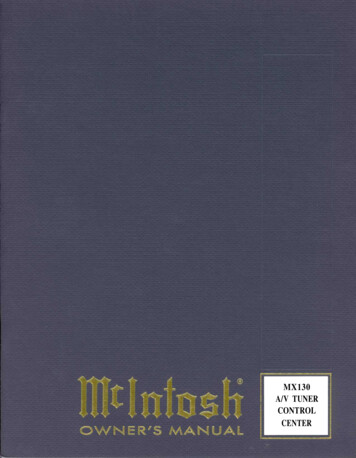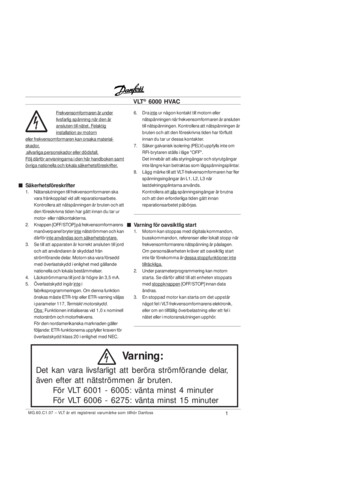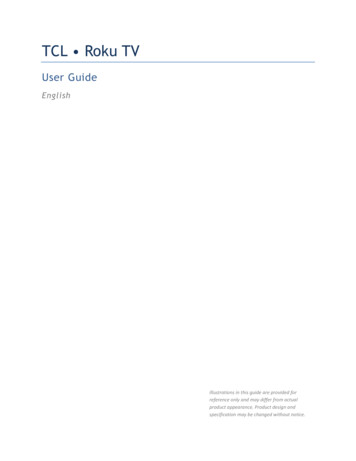
Transcription
PSG1700, Léon-HarmelQuébec (Québec)G1N 4R9Installation and Operating Instructionsfor the CADDY ADD-ON wood burningfurnaceREAD THE MANUAL THOROUGHLYBEFORE OPERATING THE FURNACECONGRATULATIONS!You have purchased one of the finest woodadd-on furnaces available on the market.Your furnace will provide years of satisfaction and safe operation.Please keep this documentCertified for Canada and the United States byOmni-Test Laboratories.REV. May 9th 200545215.
TABLE OF CONTENTSINTRODUCTION .21. CHIMNEY AND DRAFT .22. SAFETY RULES .2GENERAL REQUIREMENTS.2ODOUR FROM THE PAINT .3ASH DISPOSAL .3CREOSOTE BUILD-UP AND REMOVAL.3SMOKE DETECTOR .3DOOR GLASS .4GLASS SPECIFICATIONS.4ASH DRAWER.4ASH GRATE.43. APPLIANCE INSTALLATION .4UNIT LOCATION .5MATCHING THE TRANSFER DUCT BETWEEN THE TWO HEAT GENERATORS .5MINIMUM CLEARANCES TO COMBUSTIBLE MATERIALS FOR CADDY ADD-ON .7PIPE CONNECTOR AND DAMPER .8DAMPER .9COMBUSTION AIR.9ELECTRICAL CONNECTIONS.10THERMOSTAT .10FAN CONTROL .114. OPERATING INSTRUCTIONS.11LIGHTING.12PREHEATING .12HEATING .12EARLY SIGNS OF OVERFIRED FURNACE .13WOOD AS HEATING FUEL .13CHIMNEY FIRES.14PROLONGED POWER OUTAGE.145. MAINTENANCE .15MAINTENANCE OF THE EXCHANGERS .15CHIMNEY MAINTENANCE .16SMOKE PIPE INSPECTION.16DOOR GASKET MAINTENANCE.166. WIRING DIAGRAM CADDY ADD-ON .187. TECHNICAL DATA CADDY ADD-ON FURNACE .198. DUCTS AND DAMPERS DIMENSIONS.209. CADDY ADD-ON BRICKS LAYOUT.2110. APPENDIX 1 .2211. TROUBLESHOOTING.23PSG LIMITED LIFETIME WARRANTY.241
INTRODUCTIONTake note that this furnace operates like an EPA wood burning stove. This applies to the firing,the embers and the minimum combustion air which depends on the type and the grade of thecombustible.This model line is certified as meeting the emissions limits in 40 C.F.R. part 60, section 60.532(B) per EPA methods 28 and 5G-3, February 1988.Average emissions rate: 6.56 g/hrAverage heating efficiency: 71.43%To optimize the efficiency of your furnace, follow the following advices:Respect the local codes (when in doubt, consult your local dealer).Make sure your furnace is installed according to the instructions on the certification plate.All controls adjustments must be performed by a qualified technician. The controls settingsand the blower speed must conform to the recommendations of the Warm Air Heating and AirConditioning National Association and respect the recommended static pressure ranges in thewarm air plenum of the furnace (see General Technical data, static pressure).The wood burning Caddy Add-on furnace is approved for in-line connection to anexisting oil furnace with a firing rate of 0.8 G.P.H. (US) to 1.2 G.P.H. (US) or any gas orelectric furnace with comparable heat output.1. CHIMNEY AND DRAFTThis furnace must be connected to a chimney certified for wood burning heating appliances; a7” connector and chimney is highly recommended.If draft exceed –0.06 in. W.C a barometric damper should be installed on the smoke pipe.Never install a manual damper.The barometric damper must be adjusted so that the maximum draft measured at thefurnace outlet does not exceed -0.06 in. w.c. Please note that a draft exceeding -0.06 in. w.c.could produce an uncontrollable fire. On the other hand, the minimum draft required is -0.04in. w.c. in the evacuation pipe on the wood side.2. SAFETY RULESGENERAL REQUIREMENTSMake sure the chimney outlet and the pipes are clean and in good condition.Do not use chemical products or liquid fuel to light the fire.Do not burn wood coated with paint, glue or chemical products.Do not burn wastes or flammable liquids such as gasoline, naphtha or motor oil.Do not install an automatic feeder on this furnace.Do not store wood in the vicinity of the furnace. Respect the required clearances betweencombustible materials and the source of heat.2
WARNING-THE ASH DRAWER AND EXCHANGERS ACCESS PANEL GETVERY HOT, DO NOT HANDLE WITH BARE HANDS.ODOUR FROM THE PAINTThe furnace will release some smoke and odors when first fired; this is normal and will stopwhen the paint has finished curing. Burn the unit at high rate with windows opened until thesmoke and smell is vented out.ASH DISPOSALAshes must be placed in a metal container with a tight fitting lid. The ash container should bestored outdoors, well away from all combustible materials. If the ashes are intended to be buriedin soil, wait until all cinders have thoroughly cooled before burying.CREOSOTE BUILD-UP AND REMOVALWhen wood is burned slowly, it produces tar and other organic vapors which, when combinedwith moisture, produce creosote. The creosote vapors condense in a relatively cool chimney andflue. As a result, creosote residues accumulate on the chimney and flue linings.N.B. To minimize the frequency of the chimney cleaning, buy your firewood at least one yearbefore using it. Store in a dry place in order to obtain the minimum moisture rate and optimizethe efficiency. Do not store wood or combustible materials within the installation minimumclearances and space required to reload the appliance and remove the ashes.When ignited, creosote produces an extremely hot fire inside the chimney.To avoid this situation, it is important to do the rotation of wood. Inspect the chimney system atregular intervals to determine a cleaning cycle. A weekly cleaning might be required during mildtemperature periods but a monthly cleaning should be sufficient during cold periods. If asignificant layer of creosote has accumulated, it should be removed immediately toeliminate the risk of a chimney fire. Remember that a small hot fire is preferable to a largesmoldering one that can deposit creosote within the system. An emergency plan is necessary incase of a chimney fire. It’s important to clean the exchangers thoroughly at the end of theseason to prevent corrosion.SMOKE DETECTOR3
We highly recommend the use of a smoke detector. It must be installed at least 15 feet (4,57m) from the appliance in order to prevent a false alarm when refueling the fire.DOOR GLASSTo maintain a clean and safe installation, do not build your fire too close to the glass or allowthe logs to lean on the glass.Do not operate your furnace at too low a setting. Keep the air inlet opened long enough duringthe fire start-up to prevent the fire from going out, which would soot up the door glass.An intense fire will help keeping the glass clean. However, in the event that your glass gets toodirty, which should not occur, you will have to clean it using a wet cloth and an oven cleaner. Theglass can be cleaned ONLY when the unit has cooled down. Do not use abrasive cleanser. Youcan find special cleansers for wood stove glasses in any wood stove or hardware store.WARNING: Avoid knocking or scratching the glass which could be damaged.GLASS SPECIFICATIONSThe glass is made of Neoceram type of glass, 3/16” – (5 mm) thick.Do not operate your furnace with a broken glass, as this could seriously damage yourappliance.You can purchase a replacement glass from your PSG dealer.ASH DRAWERYour appliance is equipped with an ash drawer to collect ashes produced by the combustion ofwood. This drawer must not be left opened during combustion as this will cause over firing andserious damage to the furnace*.The drawer must be cleaned regularly.*It is mandatory that the door and the ash drawer be kept closed while the appliance is in use.Maintain all seals in good condition ; in case of deterioration, contact your dealer for replacement.ASH GRATEIn case of ash grate damage, contact your dealer to get a replacement. The steel cover on theash grate is meant to optimize the temperature inside the combustion chamber and should onlybe removed to empty the ashes.3. APPLIANCE INSTALLATION4
Before installation, please read the instructions carefully and make sure youunderstand them:The furnace must be installed in a state of the art manner. Installation must be made inaccordance with the CSA B.365(Canada) and NFPA 211(USA) standards concerning thenormalization of solid fuel units. For installation in United Sates, also refer to NFPA90B(USA) « Warm Heating and Air Conditioning Systems ». If modifications have to bemade to the existing furnace, these have to be conform with the CSA B.139 (Canada) andNFPA 31 (USA) regulation for oil furnaces.Inspect the furnace to make sure that nothing has been damaged in the shipping. Pullout the wiring kit and the instructions manual from the firebox of the furnace and thecleaning tools from the heat exchangers.UNIT LOCATIONThe furnace must be installed where outside air supply will be sufficient for proper combustion.In airtight houses, it might be necessary to install an outside air inlet (see details in: «3INSTALLATION» COMBUSTION AIR).The furnace must be positioned so that the connector is as short as possible. Minimize the useof 90o elbows.The owner must ensure a proper installation to allow a safe operation of theappliance.MATCHING THE TRANSFER DUCT BETWEEN THE TWO HEATGENERATORSInstall the plenum and heating ducts in line as in option 1 of appendix 1. In seriesconnection should be considered only if in line connection is not feasible.If the ducts are installed in series (appendix 1, option 2) and the oil furnace’s fan limitcontrol is mounted on the plenum, the divider in the plenum must be installed at least 5”(127 mm) above the fan limit control casing. This divider must be air tight.Do not install connecting ducts in a way that would allow inversion of the air flow.Do not use elbows with a radius less than 6 inches (153 mm).The transfer duct between the existing furnace and the add-on must be at least 320square inches(0.2m2) and deviations radius must be at least 6”(153mm). (see the drawingon the following page)Do not remove any safety device from the existing furnace.You must determine the air flow through the existing furnace before installing theCaddy add-on:5
1. Run the oil furnace for at least 15 minutes, or until it reaches its maximumtemperature.2. With a thermometer, measure the temperature of the cold air entering the furnaceand that of the air exiting the furnace in the hot air plenum.The temperature rise is obtained by subtracting the cold air return temperature fromthat of the air exiting in the hot air plenum.3. Make the following verifications (OIL):CFM orifice size (SI)(liter/hour) x 39 023 x E1.21 x TCFM orifice size (Imperial)(gallon/hour) x 140 000 x E1.1 x TE : Average heat generator efficiency (0.75)T : Temperature rise (ºC)4. After the installation of the add-on, the original numbers must be restored in orderto maintain a constant air flow through the furnace.6
MINIMUM CLEARANCES TO COMBUSTIBLE MATERIALS FOR CADDY ADD-ONN.B. This appliance must be installed in accordance with the instructions on the certificationplate applied on the unit.The furnace may be installed on a combustible floor.N.B. THE AIR RETURN CONDUITS SHOULD BE AT LEAST EQUAL TO THE COLD AIR PLENUMDIMENSIONS.7
PIPE CONNECTOR AND DAMPERBefore proceeding to connection, remove all accessories, such asscraper, shovel and poker from the evacuation pipe of the furnace.This furnace must be connected to a duct system and a chimney that are in good condition; the use of separatechimneys is recommended.If the furnace is connected to an oil furnace and both appliances must share the same chimney, the chimneyand smoke connector must be 7” in diameter and approved for use with wood-burning appliances. The use of 6”connector and chimney is permitted if the wood furnace evacuates into a separate chimney.It’s strictly forbidden to connect a solid fuel burning appliance to a chimney deserving a propane ornatural gas appliance. Regulation CAN-CSA-B365.1.Do not install a manual damperOIL PIPEREDUCER7" DIAMETERFor a proper installation, follow the following advices :1. All the joints of the evacuation pipe must be secured with three screws.Make sure that each screw goes through the inner wall of both connectors (male and female). Seepictures below showing a male-female coupling.PROPER INSTALLATIONFAULTY INSTALLATIONCAUSES RESTRICTION8
2. A minimum upward slope of 1/4 inch per horizontal foot must berespected.DAMPERThe barometric damper must be adjusted so that the maximum draft measured at thefurnace outlet is limited to -0.06 in. w.c. However, the minimum draft to be respected at alltimes is -0.04 in. w.c. on the solid fuel side.WARNING: DRAFT HIGHER THAN -0.06” W.C. MAY CAUSE AN UNCONTROLLABLEFIRE.COMBUSTION AIRWhen the furnace and the chimney are completely cold, it might be necessary to providefresh air by opening a door or a window for a few minutes while lighting.Take note that a house constructed or renovated in order to be airtight is liable to lack freshair which is necessary for a proper combustion and operation of heating appliances.When starting up the fire, do not operate appliances which evacuate air outside the housesuch as:-Range hood-Air exchanger-Cloths dryer-Bathroom fan-Ventilated central vacuum systemNOTE:It is recommended to install an outside air inlet of minimum 4” in diameter in or near theroom where the heating appliance is installed (see drawing on the next page). When doingso, it is preferable to choose a wall which is not exposed to dominant winds, depending on theconditions surrounding your house.9
INSULATED PIPEAIR SUPPLYAIR INLETEXTERIOR WALLN.B.The owner of the furnace is responsible for the room salubrity in case ofnegative pressure or temporary negative pressure.ELECTRICAL CONNECTIONSThe following instructions do not replace those of the local code.CADDY ADD-ONInstallation and verification of this appliance must be done by a qualified service man.Mount the fan limit control on the side of the furnace opposed to the transfer duct between the twoheat generators. Install the damper motor on the upper right side of the front panel (mounting holes arealready drilled).If the ducts are connected in series (appendix 1, option 2) and the fan limit control of the existingfurnace is located in the plenum, the divider must be installed at least 5" (127 mm) above the fan limitcasing. This divider must be airtight.All wiring and connections must be done according to the diagram. The controls of the twofurnaces must be interconnected.ATTENTION : ONLY USE WIRES SUITABLE FOR 75 C (167 F).THERMOSTATThe thermostat must be installed on an inside wall in a location where it is not likely to beaffected by the draft coming from an air outlet. It must be installed at a minimum of 55 inchesabove the floor. The two thermostats on a combined system must be installed at the sameheight. In normal bi-energy operation, the wood system thermostat should be set 2o to 3ohigher than the electric system thermostat.10
FAN CONTROLThe fan control settings vary depending on the type of installation. The “fan off” setting ispreset at 110o F at the factory. This setting should provide a proper operation in mostinstallations. The “fan on” setting is factory set at 150o F.It is preferable for a prolonged operation of the blower that the “fan off” setting be lowenough. But a “fan off” setting too low will cause undesirable cold air circulation. To modifythe setting, turn the indicator at the desired position on the temperature scale of the fan limitcontrol.The adjustment of all controls must be performed by a qualified technician. The controlsand the blower speed settings must conform to the recommendations of the “Warm AirHeating and Air Conditioning National Association”.The switch located below the fan limit control operates the low speed either at the “on”position or the “off” position. For a better efficiency we recommend to leave the high speedon automatic for heating and to use the low speed for continuous air circulation.It is possible that the blower and motor pulleys have to be replaced in order to obtain thedesired air flow through the system. (The use of a more powerful motor is permitted on thebelt driven blowers). Direct drive motors may not be replaced but they may be upgraded byreplacing the capacitor.WARNING : the blower of the existing furnace may not be changed.4. OPERATING INSTRUCTIONSStart the existing heat generator periodically to make sure it is in good workingcondition.On the wood furnaces, the thermostat controls the air inlet damper. When the thermostatcalls for heat, the damper opens and the combustion is stirred up. When the furnace gets hotenough, the fan limit control activates the blower motor at the speed selected for woodheating.The chain that links the air inlet latch to the damper motor must have a 1/8 inch play.When there is no call for heat, the air inlet latch must be completely closed and the chainmust be hooked up to the damper motor at the “8 o’clock” position. **(With all reserve for the minimum air intake to be increased depending on the type andquality of the combustible).11
LIGHTINGNEVER USE CHEMICALS OR FLAMMABLE LIQUIDS TO LIGHT THE FURNACE1. Open the doorNote: If there already is a good ember bed in the furnace, go to step b) Pre-heating.2. Remove the steel plate on the ash grate and empty the ashes in the ash drawer.3. Put the steel plate back in place, making sure it is properly seated. The steel plate on theash grate is intended to optimize the heat retention into the combustion chamber.4. Place one or two pieces of dry kindlings at the front of the furnace.5. Place newspaper strips on top of the kindlings.6. Cover the newspaper with small pieces of dry wood.7. Add newspaper strips, then light the fire as low as possible and leave the door 1/2" (13mm) opened. If lighting fails, you might experience a smoke back draft through the airinlets.PREHEATING1. Once the kindling is well ignited or the coals revived, put 2 or 3 fire logs in such a way thatthe flames can interlace between the logs and close the door. It is important to respectthese loading sequences in order for the wood to burn from the front of the furnace towardsthe back in a cigar like manner.2. Wait 15 to 20 minutes then proceed with loading the furnace.HEATING1. When reloading the furnace, first spread the embers at the center of the combustionchamber before adding new logs.2. Do not overload. Air must circulate freely in the upper part of the combustion chamber inorder to obtain an efficient operation of the appliance. Note that a small hot fire willproduce much less creosote than a large smouldering one.IMPORTANT: DURING THE HEATING PROCESS, REMOVE THE ASHESAND WOOD THAT COULD OBSTRUCT THE 1/4" (6.4 mm) HOLE LOCATEDBELOW THE DOOR INSIDE THE FURNACE.12
PROCEDURE TO OPEN THE LOADING DOORTO MINIMIZE THE RISK OF SMOKE SPILLAGE, OPEN THE DOOR 1”AND WAIT ABOUT 10 SECONDS BEFORE OPENING COMPLETELY.THE PURPOSE IS TO STABILIZE THE PRESSURE INSIDE THE FURNACE.EARLY SIGNS OF OVERFIRED FURNACE1. Roaring fire.2. Chimney connector is glowing red.3- Extreme heat coming from the furnace.If this occurs, DO NOT OPEN THE DOOR, shut-off the air inlet completely, and wait until theglow has completely subsided.ALWAYS KEEP THE DOOR AND THE ASH DRAWER CLOSED(except for lighting and maintenance).WOOD AS HEATING FUELDO NOT USE CHEMICALS OR FLAMABLE LIQUIDS TO LIGHT THE FIREPASDO NOT BURN TRASH, GASOLINE, NAPHTA, MOTOR OIL OR OTHER SUCHMATERIALS.We recommend that you burn seasoned hard wood only.There are two important factors to be considered when choosing a type of wood: themoisture content and the wood density. Hardwood, such as maple, oak or beech will providebetter results because of the high density and minimal tar produced during combustion. It ishighly recommended to use wood that has been dried at least six months. Do not use coalas heating fuel in this appliance.Whenever a high rate of smoke is noticed in the room, you must:1. Open doors and windows.2. Make sure the furnace door is closed as well as the damper (if necessary, lower thethermostat starting point or undo the chain of the damper and close the barometric controlmanually).3. When the furnace has cooled down, inspect the chimney to detect obstructions and consulta specialist to determine the cause.13
CARBON MONOXYDE IS A LETHAL GAS (ODOURLESS AND COLOURLESS), WHICH YOUMUST BEWARE OF.CHIMNEY FIRESThis might occur when the fire gets extremely hot and may be triggered by the burning ofcardboard, branches or small pieces of wood when the flame ignites the creosote residuesaccumulated in the evacuation system. The usual signs of chimney fire are:1. Rumbling2. The flue gets extremely hot3. Flames or sparks are coming out of the chimneyIn case of a chimney fire, call your local fire department immediately and sprinkle theroof around the chimney with water.Make sure that the furnace door is closed as well as the damper (if necessary, lower thethermostat setting or release the chain of the damper and CLOSE the barometric dampermanually).If the fire gets uncontrollable due to an improper use or because the draft is too strong,follow the same procedure as in a chimney fire except that you will have to OPEN thebarometric damper manually.LOCAL FIRE DEPARTMENT.Phone number:PROLONGED POWER OUTAGEIn case of prolonged power outage (more than 10 minutes), in order to diminish the risk ofoverheating, it is recommended to :- Make sure that the furnace’s damper is closed.- Open the filter compartment of the existing furnace in order to facilitate the circulationof air, through natural gravity, around the wood add-on combustion chamber.14
5. MAINTENANCEMAINTENANCE OF THE EXCHANGERSThe smoke pipe and the exchangers should be inspected regularly during the heatingseason. Easy access is provided (without the use of tools): simply unscrew the wing nut onthe exchangers’ access panel (see pictures below).Wing nutInsulationpadExchangers’ accessBefore cleaning the three exchanger pipes, move the upper plate of the combustionchamber forward (see drawing below). Using the scraper, clean the three exchanger pipes.The accumulated dirt in the side exchangers will fall into the combustion chamber; the dirt inthe central exchanger will have to be removed from the front or the back of the furnace. Makesure that the upper plate is free of ashes and do not forget to put the upper plate back inits original position. Close the exchangers access panel.15
CHIMNEY MAINTENANCEOne of the most efficient methods to sweep the chimney is using a hard brush. Brushdownwards so soot and creosote residues will come off the inner surface and fall at thebottom of the chimney where they may be easily removed.The chimney must be checked regularly and if creosote has accumulated, it must beremoved to prevent chimney fires. Cleaning on a monthly basis should be sufficient during thecoldest months.SMOKE PIPE INSPECTION-The smoke pipe should be inspected regularly during the heating season.-If possible, the smoke pipe should be dismantled and cleaned.-The smoke pipe should be inspected to detect any defect.-If no defect is noticed, put the flue back in place; otherwise, it must be replaced.-Use only wood as a combustible.Seasoned hard wood logs, 18” to 22” long, are recommended as a combustible.DOOR GASKET MAINTENANCEIt is important to maintain the door gasket in good condition. After a while, the gasket mightsag which will necessitate a door adjustment.Adjust door as follows:1. Unscrew completely the locking pin (see picture below).Locking pin2. To increase the pressure of the door on the gasket, turn the handle counter clockwise. Todecrease the pressure of the door on the gasket, turn the handle clockwise.16
3. Finally, screw back the locking pin about 1/4” deep, taking care to lock it in place with thenut.17
6. Wiring diagram Caddy Add-OnHONEYWELLL6064FANLIMITON 150 FOFF 110 FLINELOAD LIMIT 250 FEXISTING UNITTHERMOSTATBLUEREDBLACKLOW HIGH LINEDAMPERMOTORJUNCTION BOXFAN MOTOR(EXISTING UNIT)BLACKWHITEBURNER RELAYREDBLACKL2RCT TL1WHITEBLACKWOODTHERMOSTATWGYINTERLOCK18
7. TECHNICAL DATA CADDY ADD-ON FURNACECADDY ADD-ONA29 1/2"(750mm)B25 1/2"(648mm)C47 1/4"(1200mm)D28 1/2"(724mm)E24 1/2"(622mm)F44"(1118mm)G22 1/8”(562mm)H14 3/8”(365mm)FLUE6"(152mm)WEIGHT445Lb (202kg)TECHNICAL DATAMODELETEMP.BTU/HRVARIABLE(BOIS)STATIC PRESSUREMIN.H20 C( F)CADDYADD-ON26 (78)MAX.140 0000,20,619
8. DUCTS AND DAMPERS DIMENSIONSSIMPLIFIED METHODDISTRIBUTION SYSTEMHOUSE DIMENSIONSExample: 28 x 40 bungalow: 1,120 sq. ft.Ducts size (heat)4 inch outletreduce by 1”5 inch outletreduce by 2”6 inch outletreduce by 3”Always by 8” thickN.B.: The main duct must be reduced every 2 outlets.Ducts specifications (heat)DimensionsWARM AIR SYSTEM INSTALLATIONLengthElbowAverage equivalence4”10’1 x 90oMax 4,000 Btu5”10’1 x 90o6”10’1 x 90o28 x 40 x 8: 8,960 cu. ft. x 1.8 Ch. air/hr:16,128 BtuExposed walls:40 40 28 28: 136 x 8: 1,088 cu. ft. x 22:23,936 BtuNumber of windows:12 of 3 x 4: 144 x 60:8,640 BtuNumber of doors:2 x 3 x 7: 42 x 100:4,200 Btu52,904 BtuMax 6,000 BtuNon-insulated basement: 25%Insulated basement: 15%7,906 BtuMax 7,000 Btuor 54 Btu per sq. ft.60,840 BtuFOR ELECTRIC ELEMENTS 80%:DAMPER48,672 Btu or 14,28 kWTO BE ADDED: House 1 1/2 floor 25%House 2 floors 40%BEDROOM (for example: 12 x 12)For a 4” warm air outlet: 2” x 10” damperFor a 5” warm air outlet: 2” x 12” damper or 4” x 10”For a 6” warm air outlet: 2” x 14” da
The wood burning Caddy Add-on furnace is approved for in-line connection to an existing oil furnace with a firing rate of 0.8 G.P.H. (US) to 1.2 G.P.H. (US) or any gas or electric furnace with comparable heat output. 1. CHIMNEY AND DRAFT This furnace must be connected to a chimney certified for wood burning heating appliances; a











